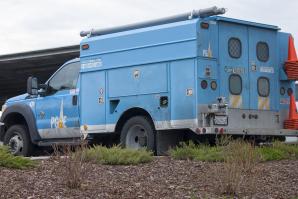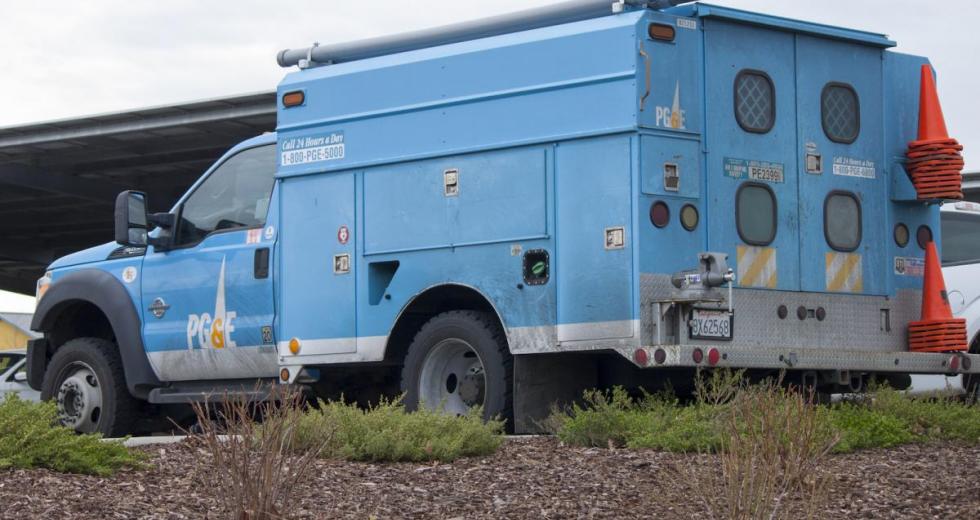As Pacific Gas & Electric Co. plans power shutdowns beginning Wednesday in parts of 17 Northern California counties due to high winds and fire danger, its management of the crisis has been widely criticized.
A few weeks ago, PG&E cut power to more than 700,000 customers. At the time, politicians and pundits pointed to San Diego Gas & Electric, which shut off electricity to about 500 customers, as a better example of wildfire preparedness.
But local critics argue SDG&E should not be put on a pedestal so quickly and the comparison is not equal.
“Are they better than the utilities in the north? Yeah, probably,” said Dianne Jacob, a San Diego County supervisor and long-time critic of SDG&E. “But does that mean that they are the gold standard? Absolutely not.”
Jacob said the utility made changes too late — only after power lines started catastrophic fires in 2007 that burned hundreds of homes and killed two people. Now, she said, they are only doing just enough to avoid being found at fault in a future fire.
“They’re more interested in covering their liability rear end than they are about looking out for those who have suffered losses and the ratepayers,” she said.
In the wake of the 2007 fires, SDG&E began using “public safety power shutoffs” as one mitigation tool. Now the shutoffs have become the new normal across California with increased wind and wildfire danger.
At a hearing Friday with the California Public Utilities Commission, PG&E CEO Bill Johnson said planned power outages could occur for the next 10 years to mitigate wind and fire dangers.
About 180,000 PG&E customers could have their electricity shut off this week.
But in San Diego, the number of customers potentially affected is much smaller than those in Northern California. SDG&E has warned 24,000 customers of possible shutoffs this week.
Since 2013, 52,000 SDG&E customers have lost power, a fraction of the more than 700,000 PG&E customers impacted in one shutoff earlier this month.
That difference in the size of the shutoffs led the California Public Utilities Commission to blast PG&E, asking why it couldn’t be more like its sister utility to the south. In a letter, the CPUC demanded substantial changes in PG&E’s power shutoff planning, including that the utility enhance efforts to minimize the size of future events.
That is a priority for SDG&E’s meteorologists working in the utility’s operations center.
Ahead of another weekend of increased fire risk, Brian D’Agostino, SDG&E’s Director of Fire Science and Climate Adaptation, was preparing to lead a team of meteorologists who would monitor the hot and dry air with strong Santa Ana winds — conditions ripe for a fire.
D’Agostino stood in front of five giant monitors showing live mountaintop cameras and yellow, blue and red lines representing the utility’s power lines.
“A major change from 10 years ago is we can see those days coming,” he said. “All of these tools analyze all of the historical data and tell us when we’re going to have that type of day that can result in a catastrophic fire.”
A SDG&E spokesperson said the utility has spent more than $1.5 billion in the past decade on wildfire preparedness. According to D’Agostino, that includes an overhaul of its grid to minimize large scale power shutoffs. Now if they shut down one line, they can still get power to areas through another route.
The design of PG&E’s transmission and distribution network makes that much more difficult, said Michael Wara, the director of the Climate and Energy Policy Program at Stanford University.
SDG&E is rolling out new technology all the time, including moving power lines underground and creating smaller grids so they can turn off power in neighborhoods or even individual households with the highest fire risk, D’Agostino said.
All of this requires data, which SDG&E collects from 190 weather stations spread across the region. PG&E also utilizes weather stations — according to spokesperson Tracy Lopez, they added 200 in 2018, and 200 more so far in 2019. The plan is to have 600 total weather stations by the end of this year. But because most of these stations have been set up so recently, Wara said the utility doesn’t yet have all the data it needs.
But is it fair to compare SDG&E and PG&E? Yes and no, said Wara.
It’s unfair for a few reasons: San Diego’s utility serves a quarter of the number of PG&E customers over a far smaller area and its terrain is less challenging to manage. SDG&E covers 4,100 square miles in San Diego and southern Orange counties. PG&E, meanwhile covers about 70,000 square miles in northern and central California.
Also, PG&E’s territory involves far more trees that need to be managed so their branches don’t come off and strike power lines, Wara said. And the fire-prone areas where the northern utility might want to cut power are far more densely populated than San Diego’s eastern county.
But in other ways, the comparison is fair, he said. After SDG&E began making major changes in the wake of the 2007 fires, PG&E should have better followed their example, he said.
“Twelve years ago SDG&E said utility-caused wildfire is not acceptable, and we need to do something about it. So they developed a whole program of activities to really reduce the risk,” Wara said. “They’re not done, but they have a process where they’re always trying to improve, where there’s no end to their efforts for risk reduction.”
He said PG&E could have also acted at that time, but didn’t.
PG&E spokesperson Lopez counters that the utility has acted to mitigate fire risk, and points to the current public safety power shutoff event as an example of how they are doing that.
But, according to Wara, PG&E “didn’t say we should be doing the things San Diego is doing, because that could happen to us.”
Now, PG&E is playing catch-up, and will not be able to improve its grid to minimize power shutoffs anytime soon, he said.
“It’s a seven- to 10-year problem,” Wara said. “In the meantime, PG&E can improve how it communicates with its customers about the shutoffs.”
—
The California Dream series is a statewide media collaboration of CalMatters, KPBS, KPCC, KQED and Capital Public Radio with support from the Corporation for Public Broadcasting and the James Irvine Foundation.
CalMatters.org is a nonprofit, nonpartisan media venture explaining California policies and politics. Comstock’s is a CalMatters media partner.
Recommended For You

PG&E Customers Face 15 Percent Increase in Bills
State authorities are already getting an earful from those overwhelming opposed to paying more
Consumer advocates worry that PG&E may try to stick customers with damages from past fires — the debt that drove them into bankruptcy.



